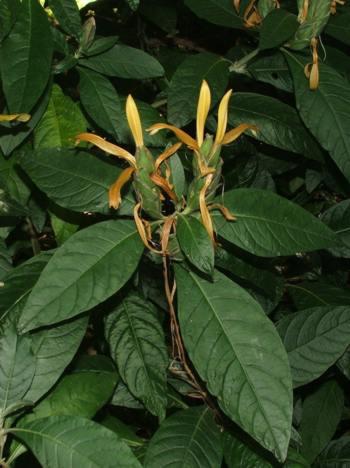Metarungia longistrobus
Metarungia longistrobus (C.B.Clarke) Baden (= Macrorungia longistrobus C.B.Clarke)
Family: Acanthaceae
Common names: sunbird bush (Eng.); sonbekkiebos (Afr.)
Introduction
Metarungia longistrobus is an unusual, attractive evergreen shrub for the shade garden, with long orange-brown flowers in candle-shaped inflorescences in late summer.

Description
Description
Metarungia longistrobus is a small, soft shrub, branching near the base to form a dense shrub 1-2 m tall with a spread of 1-2 m. Branchlets are densely covered in short white hairs that are close to the stem, and are stiff to silky to the touch.
The leaves are oppositely paired and form adjacent pairs at right angles (decussate). The leaves are narrowly elliptic, tapering at both ends, and range from 12-20 cm long and 4-7 cm broad. They are a light grey-green colour when young, becoming glossy green with maturity.

The flowers are orange-brown to yellow and are produced twice a year: mainly in late summer to autumn (January to March) but also in winter to spring (July to September). The flowers are 2-lipped, 5 cm long, the upper lip is long, narrow, hooded and erect and the lower lip is rolled and twisted. The anthers and stigma are underneath the hood of the upper lip. The flowers are produced in 5-9 cm long spikes at the tips of branches and on upper short side branches. The flowers emerge from between large, closely overlapping, green bracts, which give the inflorescence a cone-like appearance. The seeds are flattened discs 5-6 mm in diameter and are released explosively from the seed capsules.
Conservation Status
Status
Least Concern (LC). Metarungia longistrobus is not threatened.
Distribution and habitat
Distribution description
Metarungia longistrobus grows in wet to dry forest in kloofs and on rocky, wooded hillsides in Limpopo and Mpumalanga, as well as in Swaziland and Mozambique.
Derivation of name and historical aspects
History
This genus was long known as Macrorungia. Baden, who revised the genus in 1981, realized that the name was illegitimate. When Clarke transferred some members of the genus Macrorungia to Anisotes, he included the type species for Macrorungia, M. formosissima. This means that Macrorungia is a synonym for Anisotes, and that the genus to which Baden applied the name Macrorungia needed a new name. He renamed his revised genus Metarungia, which means after or with Rungia, a closely related genus. ( Macrorungia means large Rungia.)
This species is named for its long, cone-like inflorescences, longus meaning long or extended (Latin) and strobilus a pine cone (Greek).
There are only three species in the Metarungia genus: M. longistrobus, M. pubinervia and M. galpinii. M. pubinervia (Red Sunbird Bush) is widely distributed from KwaZulu-Natal into East Africa, and M. galpinii is found in the Eastern Cape.
Ecology
Ecology
Metarungia longistrobus is pollinated by sunbirds which feed on the nectar. Bees and butterflies also visit the flowers. When the seeds are ripe, the seed capsule explodes and scatters the seeds on the ground around the parent plant.
Uses
Use
Metarungia longistrobus is not used in traditional medicine. The Sunbird Bush makes an unusual and beautiful garden shrub that can be planted as a specimen shrub in the shade garden, or as part of an informal hedge, or in containers, and it attracts sunbirds, bees and butterflies to the garden.
Growing Metarungia longistrobus
Grow
Metarungia longistrobus is quick-growing and easy to grow. It needs well-drained, well-composted, fertile soil with water during the summer months. It requires a position that is semi-shaded (preferably with morning sun), or in light shade, but flowers better in a position that receives a couple of hours of sun a day. It is suitable for planting on the south (shady) side of the house. It is a low-maintenance, undemanding garden shrub. Prune in winter to keep it tidy and to encourage branching. Also suitable for containers.
Metarungia longistrobus is easily propagated from seeds and cuttings. Sow seeds from spring to early summer (October to November), using a freely draining soil mix, keep warm and moist and they will germinate in about three weeks. Take softwood, tip cuttings and use a suitable rooting hormone. Plant them in a well-aerated medium, such as peat and polystyrene and keep them in a moist, warm environment such as a mist unit with bottom heating.
References
- Baden, C. 1984. Metarungia, a valid name for Macrorungia auctt. (Acanthaceae). Kew Bulletin 39 (3): 638.
- Baden, C. 1995. Flora of southern Africa 30, 3: Acanthaceae. National Botanical Institute, Pretoria.
- Codd, L.E. Flowering Plants of Africa 47: t. 1862.
- Fabian, A. & Germishuizen, G. 1997. Wild flowers of northern South Africa . Fernwood Press, Cape Town.
- Joffe, P. 2001. Creative gardening with indigenous plants. A South African guide . Briza Publications, Pretoria.
- Red list of South African Plants, http://redlist.sanbi.org , accessed 04/06/2012
- Nichols, Geoff. Sunbird bush Metarungia longistrobus. http://www.birdinfo.co.za/botanical/nectar/24_sunbird_bush.htm , accessed 13 June 2012.
Credits
Siyasanga Yenzela and Alice Notten
Kirstenbosch National Botanical Garden
February 2013
Acknowledgements: Thanks to Ernst van Jaarsveld and Adam Harrower for their advice on the propagation techniques.
Plant Attributes:
Plant Type: Shrub
SA Distribution: Limpopo, Mpumalanga
Soil type: Loam
Flowering season: Spring, Late Summer, Autumn, Winter
PH:
Flower colour: Brown, Yellow, Orange
Aspect: Shade, Morning Sun (Semi Shade), Afternoon Sun (Semi Shade)
Gardening skill: Easy
Special Features:
Horticultural zones











Rate this article
Article well written and informative
Rate this plant
Is this an interesting plant?
Login to add your Comment
Back to topNot registered yet? Click here to register.